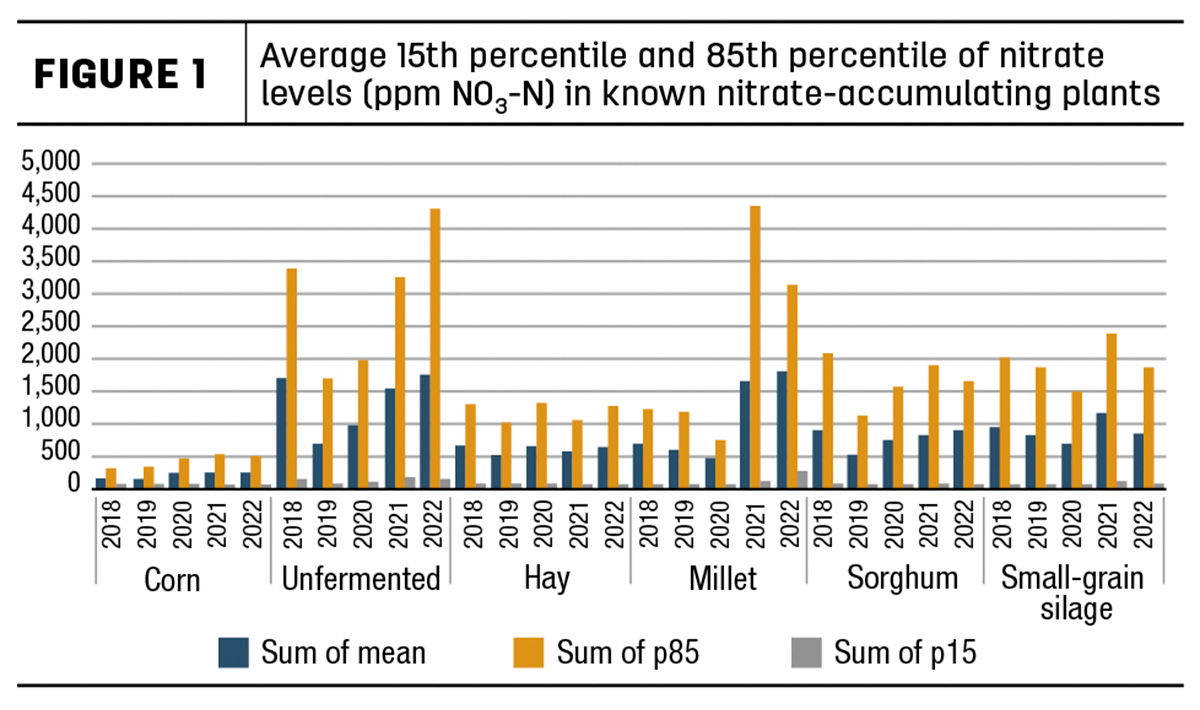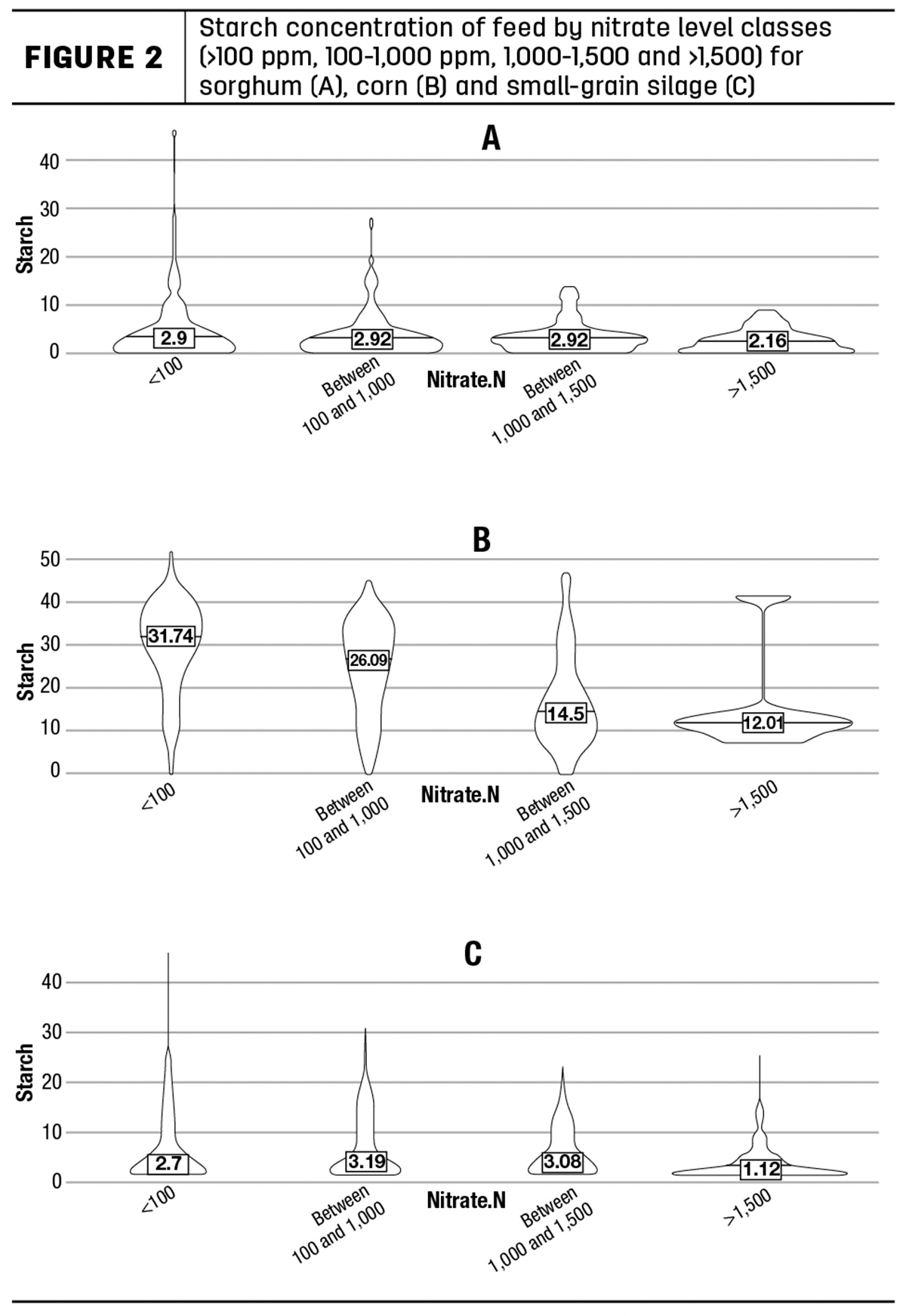Living in an area where flash flooding is prevalent, I often hear about the importance of flood safety. However, when discussing feeding cattle, I’m often faced with questions about drought safety. Drought is not often associated with catastrophic damage such as water; however, it can have catastrophic impacts – especially for animal feeding operations. One important consideration is the potential accumulation of the toxic compounds nitrate and prussic acid in drought-stressed forages. When considering these compounds, questions about nitrate or prussic accumulation in drought-stressed forages, prevalence of such issues and testing for nitrates arise.
Forage shortages across the country have caused increasing pressure to secure hay at any cost. According to the USDA estimates, states such as Texas, Nebraska, Kansas and Oklahoma may be down over 15% of total hay supply in 2023, as compared to 2021. When considering forage purchases, understanding risk factors can help ensure the hay purchased is safe for the desired class of cattle. For producers who may not need to purchase feed, managing these risk factors on grown feeds can also ensure cattle safety in drought.
These compounds are particularly toxic to ruminants because nitrate is ingested and converted to nitrite by bacteria in the rumen. When these levels are low, the bacteria will convert this nitrite to NH3. When nitrate levels are too high, nitrite can accumulate and be absorbed into the blood. This forms a compound with hemoglobin, methemoglobin and limits the blood's ability to carry oxygen – eventually causing suffocation. Pregnant cows are most at risk for nitrate toxicity, and unsafe levels can cause calf loss. Although nitrate toxicity can be acute or chronic, in my experience, chronic nitrate toxicity seems to be more common. Prussic acid, also known as cyanide, is a rapidly acting toxin that acts on a cellular level to inhibit oxygen utilization, causing a quick and sudden death after exposure. Bacterial enzymes in the rumen cause the prussic acid to be released in the digestive tract, resulting in these catastrophic outcomes.
Nitrates are a compound produced in certain forages when stress or rapid growth limits the plants’ ability to assimilate protein from soluble nitrogen in the soil. The most common culprit for nitrate accumulation is rainy periods following drought; however, nitrates can also accumulate during extended periods of cloudy or cool weather when the plant is lacking important nutrients to allow the protein assimilation process to be completed. Improper nitrogen fertilization can also lead to higher nitrate levels in forages. Common forages known to accumulate nitrates are sorghum, sorghum-sudan, pearl millet, rye, wheat and corn (Figure 1). Nitrates can also occur in common weed species such as pigweed, horse nettle and jimsonweed. Nitrates often accumulate in the stalks of the plant because the plant uptakes nitrogen in the soil and it moves up through the stalk to be assimilated into protein. When there is a missing factor needed to complete the assimilation, nitrate accumulates in the stalk. Commonly, this missing factor is water or energy from photosynthesis.

Prussic acid, on the other hand, is prevalent within the leaves of plants. It accumulates in response to drought, most often after a period of rapid growth following a freeze or rain event. Larger plants may be at slightly lower risk of toxicity thanks to increased dilution across the plant; however, this risk can still exist. Prussic acid is found in sorghum, sudangrass, sorghum-sudan hybrids and johnsongrass.
So what do we do when environmental conditions favor the production of these compounds, and how do we manage risk? First and foremost, there is no substitute for testing forages. There have been many circumstances where environmental conditions have favored nitrate or prussic acid production; however, levels are moderate and feed can be safely fed. On the other hand, I have seen extremely high levels of these toxic compounds exist where they were not initially suspected. For forages that are purchased, and management and fertilization history is unknown, testing is of the utmost importance.
Feed that tests high in nitrates or prussic acid can eventually be fed if managed correctly, as both nitrates and prussic acid can dissipate over time. For nitrates, proper harvest management can help decrease risk. When faced with a rain event following drought, waiting to harvest can allow the plant time to assimilate the nitrogen into a complete protein. Ensuring the plant also has plenty of sun prior to harvest, as well as harvesting in the afternoon, will help ensure the plant has the needed carbohydrates to complete the assimilation process.
If feed still has high nitrates after these steps, ensiling can help to decrease the nitrate level. However, even if these steps are taken, one should never assume nitrates are reduced, and testing prior to feeding is still necessary to ensure the feed presented to the animal is safe. As touched on above, when grazing it is important to keep in mind that weeds can accumulate nitrates. Pastures that may not have adequate grass supply can pose a higher risk, as cattle may ingest more potentially toxic weeds due to low grass availability. In purchased feed, low starch levels in plants that would typically produce high starch may be a sign that the forage was stressed and could be at risk for nitrates. Figure 2 illustrates this concept. Regarding prussic acid, research to this point suggests waiting seven days after a period of rapid growth to graze or chop plants, allowing this compound to be released in a gaseous form. Sun curing can also help this process in plants that will be used in hay.

Nitrates and prussic acid accumulation potential can be managed, but this may not mean challenges won’t arise. Management practices such as spreading out nitrogen applications, irrigation and seed selection for low prussic acid can all reduce risk. One research study suggested that pearl millet hybrids may differ in the amount of nitrate accumulated. However, outside of this study, there is little research looking into this hypothesis. Low-phosphorus soil may actually increase risk of prussic acid accumulation, so proper soil testing and fertilization can help decrease this risk.
Nitrate and prussic acid occurrence and management is not an exact science. At times, I find myself scratching my head wondering why some crops have extremely high levels while others nearby may test at manageable levels. One thing is certain: With today’s high cattle prices, cattle loss due to nitrate or prussic acid accumulation is not a risk worth taking. Understanding management practices that can help decrease risk and, most importantly, testing is an effective way to help manage drought-stressed feed safely.









